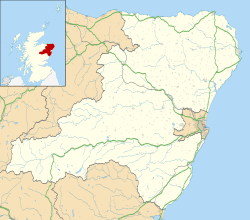Fraserburgh Old Parish Church facts for kids
Quick facts for kids Fraserburgh Old Parish Church |
|
|---|---|
 |
|
| 57°41′38″N 2°00′32″W / 57.694°N 2.009°W | |
| Location | Fraserburgh |
| Country | Scotland |
| Denomination | Church of Scotland |
| Churchmanship | Reformed |
| Website | www.fraserburgholdparishchurch.org.uk |
| History | |
| Founded | 1571 |
| Administration | |
| Parish | Fraserburgh |
| Presbytery | Buchan |
| Synod | Grampian |
Fraserburgh Old Parish Church was a church building in Fraserburgh, Scotland. It was part of the Church of Scotland. The building you see today was built in 1803. It stands where a much older church from the 1500s used to be. This church is considered an important historical building.
Contents
History of Fraserburgh Old Church
The church was started in 1571 in a small village called Faithlie. This village later grew into the town of Fraserburgh. Sir Alexander Fraser, a local landowner, helped build the town. The church was one of the first new buildings in Fraserburgh, after the castle at Kinnaird Head.
Early Challenges and Changes
From 1571 to 1600, the official religion in Scotland was Presbyterianism. This was because of the Scottish Reformation in 1560. But in 1600, King James VI changed the official religion to Episcopacy.
The minister at Fraserburgh Old Church, Rev. Charles Ferm, was a strong Presbyterian. He did not agree with the King's new religious rules. He even joined other ministers who disagreed with the King. Because of this, he was put in prison for a year. Later, he was sent away to an island for almost three years. He was allowed to return to his church in 1609. After he died, the church slowly became more Episcopal.
Not much is known about the church for the next 100 years. It seems things were quiet, suggesting the church had accepted the Episcopal way.
Returning to Presbyterianism
In 1689, after a big change in government called the Glorious Revolution, Presbyterianism became Scotland's official church again. Just like before, Fraserburgh had a minister who followed the old ways. The people of the town also seemed to prefer the Episcopal style.
The Episcopal minister, Rev. James Moore, was allowed to stay until he died in 1703. His son, Rev. Alexander Moore, then tried to take over. This was against the new laws. The church was officially empty until 1706. Finally, a Presbyterian minister agreed to come.
When church officials tried to bring in the new minister in 1706, people stormed the church! The official was even thrown out of the pulpit. After this, the local lord, Lord Saltoun, asked for Rev. Moore to be allowed to stay. This was refused. In 1707, Rev. Alexander Auchinleck became the first Presbyterian minister of Fraserburgh in nearly a century.
He found that only half the people who used to attend came to his services. Even though he worked hard for 47 years to grow the church, people who preferred the Episcopal way tried to take over the church several times until the 1740s. Despite these difficult beginnings, Presbyterianism has continued in the church ever since.
The 1800s and Beyond
The 1800s brought fewer big problems for Fraserburgh Old Church. Because of the earlier riots, a new church building was built in 1802-1803. This is the building that stands today. Its inside has been updated many times.
In 1843, the Disruption of 1843 happened, where many ministers left the Church of Scotland. The minister at Fraserburgh Old, Rev. John Cumming, surprised everyone by staying with the main church. He was known for arguing a lot. He even removed one of his assistants for "misconduct."
In the 1860s, under Rev. Peter McLaren, the church helped expand education in the area. McLaren is known for starting three new schools. During his time, the church was very powerful and important in the town.
Later, Rev. Michael P. Johnstone oversaw big renovations to the church, making it look much like it does now. A new pipe organ was installed in 1898. In 1906, a beautiful stained-glass window was added.
The church almost faced destruction during the Second World War. During a bombing raid, a piece of metal fell through the roof, chipping the pulpit. People still call this mark "Hitler's mark."
Recent Times
In more recent times, Rev. Douglas R. Clyne worked hard to grow the church's youth groups. In 1976, a building called the "Penny Schoolie" was updated for youth activities. A new church center was built in the early 1990s. The church has held a special "Youth Dedication Service" every year.
Today, the church has many groups for young people, including a Badminton Club, Boys' Brigade, Covenanters, Girls' Brigade, and a Junior Choir. There are also Sunday School groups and social groups for adults.
Rev. Clyne retired in 2004. After a few years without a permanent minister, Rev. Peter B. Park joined in 2007. He helped start a hand bell group called The Clangers. Rev. Park retired in June 2014.
In June 2024, the Church of Scotland decided to close the Fraserburgh Old Parish Church building. This was part of a plan to combine several churches in the area into one new church called Fraserburgh & District Parish Church. The final service in the Fraserburgh Old Parish Church building was held in June 2024.


